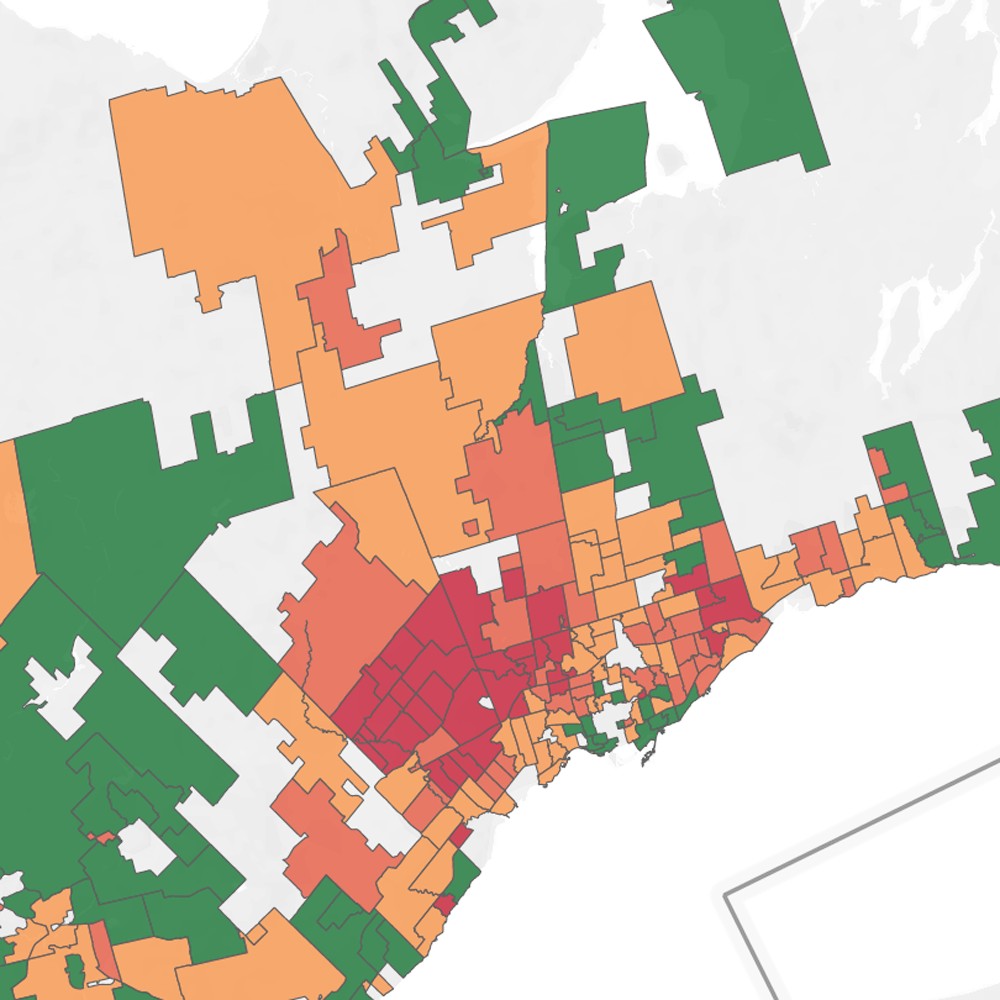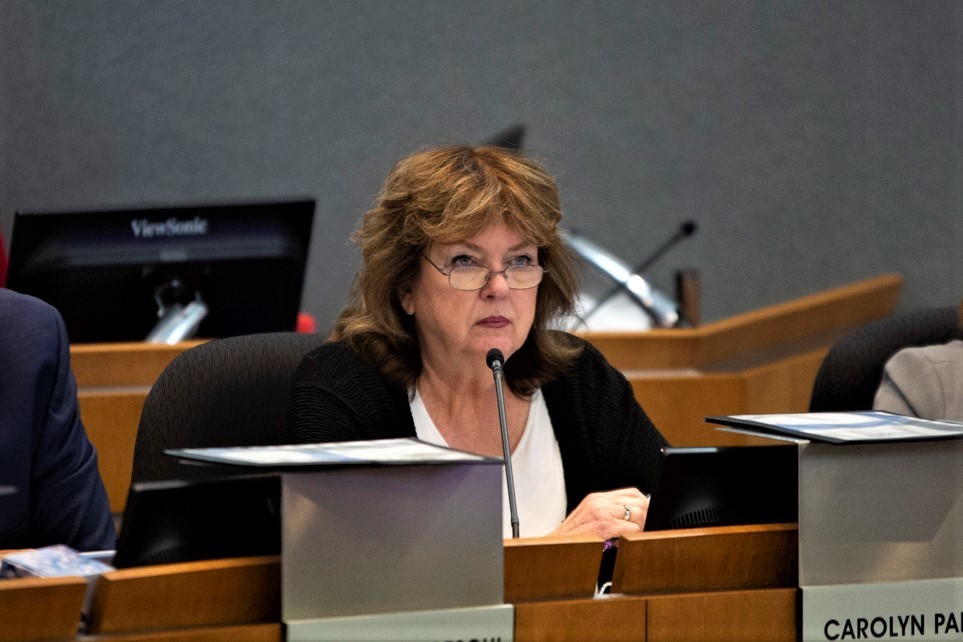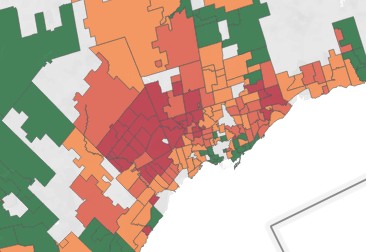
Peel neighbourhood positivity rates as high as 20%
Shoppers were greeted with long lines outside several Heartland Town Centre stores this past weekend, spaced out by pavement markers every two metres. For drivers passing by the busy Mississauga shopping plaza, the view of stretched queues and cars spilling out from parking lots would hardly inspire a stop for errands.
Premier Doug Ford urged residents of Peel and Toronto not to panic-buy or stockpile goods when he announced the two regions would enter a lockdown beginning November 23.
Human nature didn’t listen.
The second wave of COVID-19 continues to curve upward at an alarming rate in Peel. For six days in a row, between November 18 and November 23, the region’s COVID-19 case count was the highest in Ontario with provincial data reporting between 361 and 535 cases per day. Peel’s figures represent a significant portion of the total case count in Ontario each day, peaking at 38 percent of the province’s new infections on Saturday, in a region that accounts for about 10 percent of the province’s population.

The Region of Peel continues to make up a large percentage of Ontario's new COVID-19 cases.
Tuesday’s low case count, at 175, was not a result of fewer cases, but the product of a technical error that overestimated the previous day’s numbers, Health Minister Christine Elliott said in her daily update via Twitter. The Province reported 415 new cases in Peel on Wednesday (almost double Toronto’s per capita figure) and 16 deaths.
As of November 24, Peel Region continued to lead the province with the highest cumulative rate per 100,000 people, at 1425.4 cases per capita, followed by Toronto at 1193.1 cases, according to an epidemiologic summary by Ontario Health. The weekly incidence rates are also at record highs, with the latest Peel Public Health per capita data showing 298 cases per 100,000 residents in Brampton, followed by 118 cases per capita in Mississauga and 115 in Caledon.
The latest lockdown measures are an “emergency brake” for Peel that health officials hope will drive down in-person interactions and lower the number of new infections, said Dr. Lawrence Loh, Peel’s Medical Officer of Health, in an interview Friday.
“However, I want to also make very clear that this doesn’t address the underlying issues,” he said, regarding income relief for essential workers and self-isolation options for residents who live in large households. Peel’s health unit has reached out to community leaders and organizations to better communicate the need to access social supports, including paid sick leave and certain eviction protections, to discourage residents who may be experiencing COVID-19 symptoms from going to work.
Ward 5 Councillor Carolyn Parrish criticized the lockdown measures in a Mississauga budget committee meeting Monday, arguing to her peers that the City should not be facing the same restrictions as the Region.
“First of all, I think we need to start pressuring Dr. Loh into separating out Brampton and Mississauga, and I'm sure Caledon’s screaming as well. People are fed up,” she said. “So, all these lovely plans about how we're going to sell this [lockdown] to people, they're not buying it anymore.”

Mississauga Councillor Carolyn Parrish.
Rates of infection in Brampton have been much higher than its slightly larger neighbour to the south, but both have been treated as one jurisdiction by public health officials since the start of the pandemic.
Mayor Bonnie Crombie defended the lockdown move by quoting from the Region’s latest epidemiological data, which has her City at a weekly COVID-19 incidence level three times higher than what the province’s “red-control” stage recommends. The most recent data also has Brampton at a 15.3 percent positivity rate, Mississauga at 7.8 percent and Caledon at 6.5 percent test positivity.
In some neighbourhoods in Brampton and Mississauga, the COVID-19 positivity indicator is even higher than the city rate – and many Peel neighbourhoods have the highest figures in the province.
As of November 24, the northeast corner of Brampton is now registering a 20.3 percent positivity rate, followed by an area in Malton at 19.2 percent, and a Mississauga postal code, that borders Toronto Pearson
International Airport and the International Mail Processing Centre, is at 16.7 percent, according to data analysis by the Toronto-based non-profit ICES.

![]()
Many Peel neighbourhoods are seeing COVID-19 positivity rates well above the provincial average.
(For more information - HowsMyFlattening)
ICES, formerly called the Institute for Clinical Evaluative Sciences, began tracking positivity data by neighbourhood following a request from Toronto Public Health, said Dr. Jeff Kwong, a physician and senior scientist. This sparked the idea to track hyper-local COVID-19 positivity rates based on postal codes and data generated from the Ontario Laboratories Information System, where all lab results are documented, to provide more targeted information to public health units.
“The issue is that the health units don't have access to all this [data], so it would be a lot harder. I don't think it's possible for them to do this report,” he said, because the units may not have information on the number of tests completed.
Dr. Kwong is encouraged by testing data that shows the most hard-hit areas of Peel are also getting the most testing resources.
“The good news is that we are testing more in the areas where there's higher percent positivity, which means that...we're [not] doing a lot of tests in areas where they don't need to be done,” he said.
Dr. Kwong was among researchers at ICES and the University of Toronto who analyzed individual and social determinants for COVID-19 testing among 14.7 million Ontarians, in a study published earlier this month, awaiting peer review. They found household size, education level, and recent immigration to Canada are among the prominent social factors associated with an increased risk of contracting the virus that causes COVID-19. The analysis spans from March to June, when close to 760,000 tests were completed with a 3.3 percent positivity rate, or about 25,000 COVID-19 cases.
To optimize the success of health interventions, officials should not apply a homogenous approach across populations, the study recommends, and instead should be tailored to social risk factors such as household density and barriers to healthcare, including systemic discrimination and lack of access to services.
Unequal privilege and opportunity to choose work arrangements are exacerbating the damage of COVID-19 in many South Asian-Canadian communities whose members are a prominent part of the transport and manufacturing industries, the World Sikh Organization of Canada said in a news release.
“Communities, such as Brampton, that are becoming the epicentre of the COVID-19 outbreak need target investments for more testing capacity and isolation centres and there needs to be better employment protections for the working class,” said organization president Tejinder Singh Sidhu.
The cases are also burdening a strained hospital system. Patients with COVID-19 in the Trillium Health System doubled to 43 two weeks ago, and rose again to 61 patients this week, 14 of which are in critical care.
Trillium is also grappling with active outbreaks at Mississauga Hospital in the orthopaedic and COVID-19 care units, and declared an emergency department outbreak over last Wednesday. Across Trillium sites, there were 14 staff who tested positive for COVID-19, having contracted the virus from the community and hospital, a spokesperson confirmed Friday.
William Osler Health System is treating 62 COVID-19 patients, with 11 in critical care across the system which includes Brampton Civic Hospital.
On Monday, the Province announced it was deploying COVID-19 rapid tests and rapid antigen tests to help regions, including Peel, experiencing high transmission, and in settings such as long-term care homes and remote communities.
Email: [email protected]
Twitter: @LaVjosa
COVID-19 is impacting all Canadians. At a time when vital public information is needed by everyone, The Pointer has taken down our paywall on all stories relating to the pandemic and those of public interest to ensure every resident of Brampton and Mississauga has access to the facts. For those who are able, we encourage you to consider a subscription. This will help us report on important public interest issues the community needs to know about now more than ever. You can register for a 30-day free trial HERE. Thereafter, The Pointer will charge $10 a month and you can cancel any time right on the website. Thank you.
Submit a correction about this story


